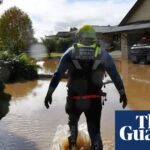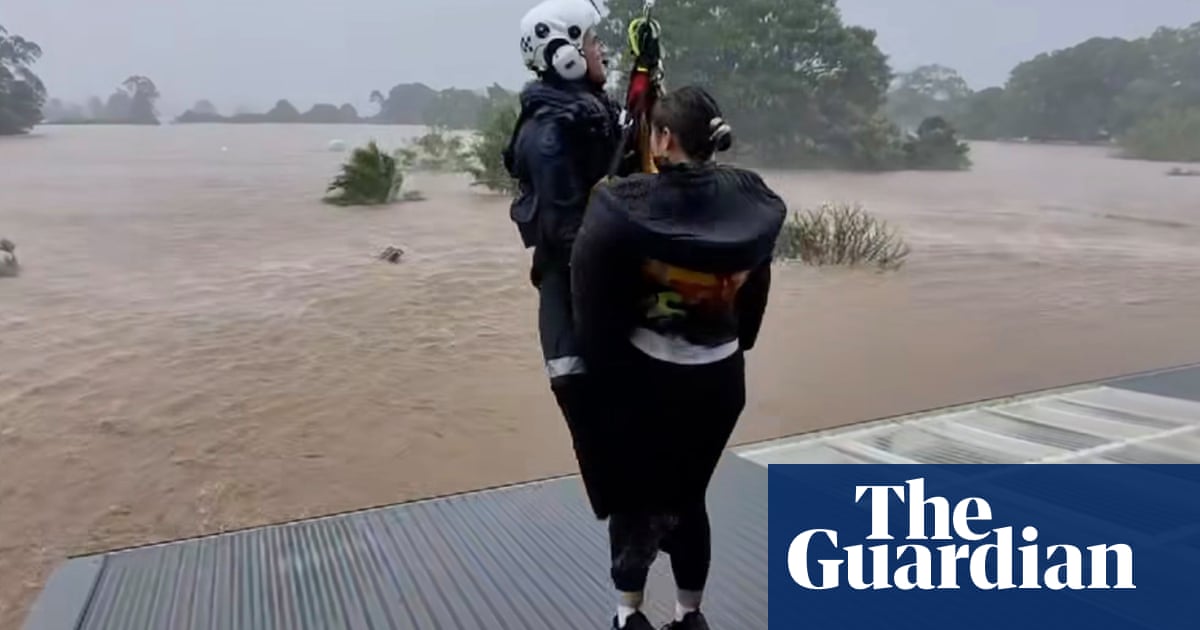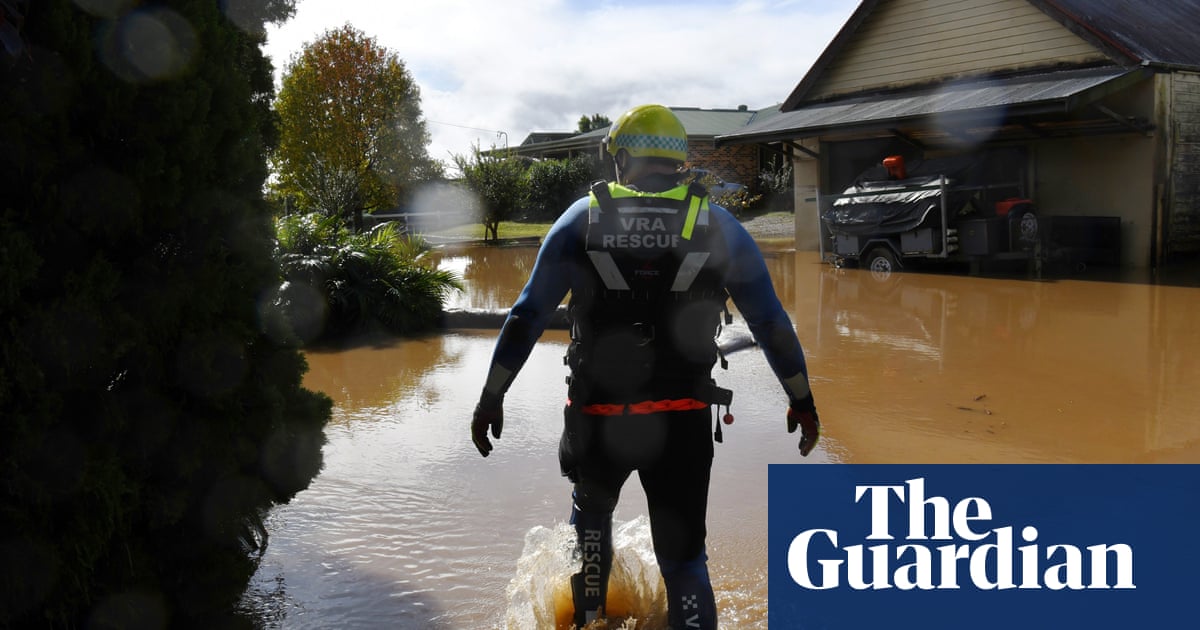Devastating floods along Australia’s east coast have killed at least one man, after a body was found on a flooded property.
Emergency services were called to Moto, on the NSW mid-north coast, on Wednesday afternoon and located the body of the 63-year-old.
NSW Police said he was in a house impacted by flooding and that a report will be prepared for the coroner.
The NSW premier, Chris Minns, said communities in rain-affected areas along the north coast of the state need to brace for “more tough times” in the next two days.
“It’s very sad, and when there’s these terrible natural disasters, they hit ordinary families in terrible ways. and our heart goes out to obviously that man and his family,” he told Nine’s Today show on Thursday.
“I’m very grateful we’ve got thousands of volunteers and the local community has really rallied in the last 48 hours, but they’ve needed to.”
Heavy rain was predicted to hammer the mid-north coast of New South Wales and further north until Friday morning, with “heavy, localised intense rainfall” expected to cause more difficulty and anguish for almost 50,000 people isolated by rising flood waters.
The Bureau of Meteorology (BoM) issued a severe weather warning shortly after 4am on Thursday morning which expanded the zone from the already badly hit Hunter Valley and mid-north coast regions to include the Northern Tablelands, Northern Rivers and North West Slopes and Plains.
“Areas of heavy rainfall are expected to persist through Thursday as a weak low-pressure system develops within the trough, and it slowly moves further southwards throughout the day,” the BoM warning said.
It said heavy rainfall was forecast to continue over north-eastern parts of the state overnight on Wednesday and during Thursday bringing 24-hour rainfall totals of up to 300mm in some areas.
“Locally intense rainfall which may lead to dangerous and life-threatening flash flooding is also possible for parts of the mid-north coast district and adjacent Northern Tablelands during Thursday,” the notice said. “This includes Kempsey, and coastal areas around Coffs Harbour and Nambucca Heads. Six-hourly rainfall totals between 100 and 150 mm are possible with 24-hourly rainfall totals reaching between 200 and 300 mm.”
Some 115 warnings were in place on Wednesday night, with local residents in the path of flooding urged to head to higher ground and evacuate if they could. The SES carried out more than 300 flood rescues on Wednesday alone, using helicopters to winch stranded residents off their roofs.
The NSW SES commissioner, Michael Wassing, said rescue conditions had been difficult and dangerous.
“I cannot stress enough that it is important to heed the warnings of evacuations,” he said. “I cannot guarantee that our crews will be able to immediately rescue people.”
“Super saturated” river catchments were responding quickly to the rain, he said.
Evacuation centres have been set up at Dungog, Gloucester, Taree, Manning Point, Wingham, Bulahdelah, Tuncurry Beach, Kempsey and Port Macquarie.
The federal emergency management minister, Kristy McBain, said the commonwealth was working with the NSW government to provide support in 16 local government areas.
“These floods and severe weather are having a huge impact on communities,” she said.
The bureau had said late on Wednesday afternoon said that further rainfall would likely lead to prolonged major flooding and increase flooding on many rivers in the upper Hunter and the mid north-coast.
Helen Holliday runs a medical practice with her husband in the centre of Taree.
On Wednesday it was too early to assess whether it had been affected by flood waters because the roads into town were inaccessible.
“We did the best we could, sandbagged, but the power had to be turned off, so we’ve lost all of our vaccines,” Holliday said.
With the practice’s systems down, she said the doctors were not able to work.
“It’s just really frustrating when the community needs you and people are so stressed,” she said.
Holliday said on Tuesday night many local businesses had evacuated, with some shops moving their stock to higher ground. She said some cafes and restaurants that had been helping community members by providing free meals had since flooded.
after newsletter promotion
The NSW State Emergency Service on Wednesday said more than 48,800 people and 23,200 dwellings had been cut off by flood waters.
The SES had made 400 rescues since the flooding hit.
The majority of the rescues were in Taree, Wingham and Glenthorne. Forty flood rescue teams were working between the Hunter and Coffs Harbour, with helicopters, boats and ground crew supporting operations, the SES said.
Much of the mid-north coast has been deluged with two-day totals of between 200 and 400mm, which had led to major flooding, Narramore said on Wednesday.
SES flood rescue teams on Wednesday were going door-to-door checking on residents whose homes had been isolated, Dean Storey, the SES assistant commissioner, said. Anyone trapped should call triple-zero, he said.
Storey said more evacuations were expected between Port Macquarie and Coffs Harbour, particularly around Kempsey.
“We are asking people in these high-risk areas not to wait until it’s too late – know what you will do if you do need to leave, and immediately follow the advice of emergency services,” he said.
The NSW SES state duty commander, Colin Malone, told the ABC on Wednesday evening that there were 25 emergency warnings in place, out of a total of 121 warnings, as well as 64 watch and acts. He urged residents to leave early.
“Don’t wait to be told to get out. If you can go early … that’d be amazing, because that means … if we have to trigger an evacuation during the night, which we don’t like doing … people are ready and there’s less people.”
Malone said 24 people had to be rescued after driving through flood waters, which made rescues particularly challenging.
“Where we’re going to the rescues where somebody made that choice to drive through flood water, which we always will do, we’re tying up a resource that could be going to help somebody in their house or in another location.”
Holliday said areas including Taree South and the suburb of Purfleet were “a disaster” and “everyone in town will know someone who has lost everything”.
“How much does it take for people to understand that we have a climate emergency?” she said.
“We’re going to have to work to try to mitigate this. It’s going to happen across Australia more and more, we’re going to see these huge events.”
On Wednesday, the Manning River surpassed its 1929 record flood level.
The chief executive of Natural Hazards Research Australia, Andrew Gissing, said the record breaking flooding along the Manning River had an estimated frequency of occurrence of one in 500 years on average.
“Though it is too early to know the extent that climate change has contributed to the extreme rainfalls, we do know that under a warmer climate that our atmosphere holds more water and that heavy rain events are more likely,” he said.
Evacuation centres have been opened at:










